How are gorilla groups allocated? Gorilla tracking is arguably the most fascinating wildlife experience in Africa. It is a very different experience from a game drive in the Masai Mara or Serengeti National Park. It is more of like paying a visit to our ancestors. Each year, tens of thousands of people come to Africa to see these majestic primates in the wild. Mountain gorilla tracking is even more popular because they are 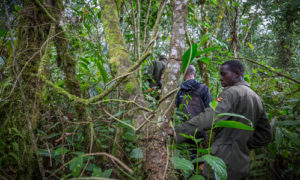 listed as endangered by the IUCN. Because of their low numbers, they attract more publicity and visitors than their lowland cousins.
listed as endangered by the IUCN. Because of their low numbers, they attract more publicity and visitors than their lowland cousins.
Mountain gorillas live in groups or families consisting of about 20 members on average. Not all the gorilla groups are open to visitors – some of the groups remain wild. There are 34 mountain gorilla families which are currently habituated and open to tourists. 8 of them are found in the Democratic Republic of Congo, 10 in Rwanda and 15 in Uganda.
The best gorilla groups to track
Which is the easiest gorilla group to track? Which is the best gorilla family to track? In all the gorilla parks, there are gorilla groups that are easier to trek and those that are more difficult to find. It can take only 30 minutes to find some gorilla groups while it may take six hours to find others. Gorilla groups in Rwanda are generally considered to be easier to track but that that can also be said for Mgahinga national park and some of the gorilla families in Bwindi and Virunga National Park. Bwindi has almost twice the number of habituated gorilla families in Rwanda. Most are easy to track but the rest can be difficult to find.
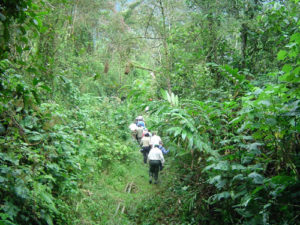 It is important to note that gorillas are wild creatures. Just because your friend or someone on the web discouraged you from tracking a certain gorilla group doesn’t mean that the composition or circumstances surrounding the group are still the same. If the group didn’t have a silverback in 2011, then it could be having two at the moment. If a particular gorilla group didn’t have infants or babies at one time, it could be having twins as I write this article. The gorilla family that was difficult to reach could have migrated closer to the park offices. Let us discuss the different gorilla groups in Uganda, Rwanda and Congo.
It is important to note that gorillas are wild creatures. Just because your friend or someone on the web discouraged you from tracking a certain gorilla group doesn’t mean that the composition or circumstances surrounding the group are still the same. If the group didn’t have a silverback in 2011, then it could be having two at the moment. If a particular gorilla group didn’t have infants or babies at one time, it could be having twins as I write this article. The gorilla family that was difficult to reach could have migrated closer to the park offices. Let us discuss the different gorilla groups in Uganda, Rwanda and Congo.
Gorilla groups in Uganda – How to get an easier gorilla family to trek
The gorilla families in Uganda are found in two national parks – Mgahinga and Bwindi. Mgahinga has only one habituated gorilla group – the Nyakagyezi group. Bwindi has more mountain gorillas than all the other national parks. The gorilla families in Bwindi are scattered in four sectors of the park – Ruhija, 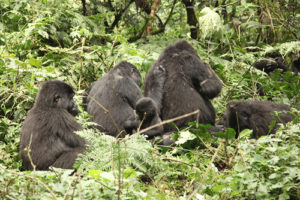 Rushaga, Nkuringo and Buhoma. The gorilla families in Ruhija sector of Bwindi are Rushegura, Habiyanja and Mubare. Those in Buhoma are Bweza, Mishaya, Busingye, Nshongi and Kahungye. The gorilla groups in Buhoma are Kyaguliro, Oruzogo and Bitukura. Nkuringo sector has the Nkuringo gorilla group while Rushaga has Bushaho and Bikyingi. Rushaga is special because it offers visitors a chance to take part in the gorilla habituation experience. The gorilla habituation experience can only be done in Uganda and involves more hours with the gorillas. Which is the easiest gorilla group to track in Bwindi? The Rushegura Gorilla Group in Buhoma sector is generally thought to be the easiest group to track. However, in some seasons, the group can decide to move further away from the park. There is therefore no guarantee that you will have an easier trek.
Rushaga, Nkuringo and Buhoma. The gorilla families in Ruhija sector of Bwindi are Rushegura, Habiyanja and Mubare. Those in Buhoma are Bweza, Mishaya, Busingye, Nshongi and Kahungye. The gorilla groups in Buhoma are Kyaguliro, Oruzogo and Bitukura. Nkuringo sector has the Nkuringo gorilla group while Rushaga has Bushaho and Bikyingi. Rushaga is special because it offers visitors a chance to take part in the gorilla habituation experience. The gorilla habituation experience can only be done in Uganda and involves more hours with the gorillas. Which is the easiest gorilla group to track in Bwindi? The Rushegura Gorilla Group in Buhoma sector is generally thought to be the easiest group to track. However, in some seasons, the group can decide to move further away from the park. There is therefore no guarantee that you will have an easier trek.
Gorilla families in Rwanda – How are gorilla groups in Rwanda allocated?
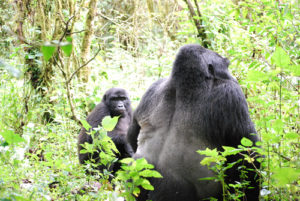 Rwanda has the second highest number of mountain gorillas after Uganda. The gorillas live in 10 habituated groups. Rwanda has an advantage over Uganda and Congo in that the gorillas can be accessed more easily from the capital Kigali in a journey that takes only 2 hours. The gorilla groups in Rwanda include, Agashya, Amahoro, Bwenge, Hirwa, Kwitonda, Sabyinyo, Susa A, Susa B and Ububano family. Amahoro gorilla family is said to be the best gorilla group to track but as we already mentioned earlier, nothing is guaranteed. Susa A is said to be the hardest to track but is still popular among tourists because it is the group the Dian Fossey studied.
Rwanda has the second highest number of mountain gorillas after Uganda. The gorillas live in 10 habituated groups. Rwanda has an advantage over Uganda and Congo in that the gorillas can be accessed more easily from the capital Kigali in a journey that takes only 2 hours. The gorilla groups in Rwanda include, Agashya, Amahoro, Bwenge, Hirwa, Kwitonda, Sabyinyo, Susa A, Susa B and Ububano family. Amahoro gorilla family is said to be the best gorilla group to track but as we already mentioned earlier, nothing is guaranteed. Susa A is said to be the hardest to track but is still popular among tourists because it is the group the Dian Fossey studied.
Gorilla Groups in Congo – The best gorilla group to track
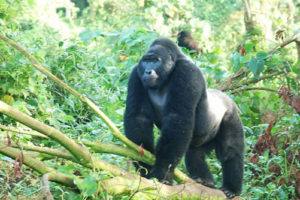 The Democratic Republic may have only 8 gorilla groups but it stands out because it is the only country where one can spot both mountain and lowland gorillas. Combining mountain gorilla trekking in Virunga, hiking the Nyiragongo volcano and lowland gorilla trekking can make for an amazing experience. Gorilla permits in Congo cost $400. This is very low when compared to the $600 in Uganda and $1500 in Rwanda. The gorilla families in Congo include Bageni, Humba, kabirizi, Lulengo, Mapuwa, Munyaga, Nyakamwe and Rugendo.
The Democratic Republic may have only 8 gorilla groups but it stands out because it is the only country where one can spot both mountain and lowland gorillas. Combining mountain gorilla trekking in Virunga, hiking the Nyiragongo volcano and lowland gorilla trekking can make for an amazing experience. Gorilla permits in Congo cost $400. This is very low when compared to the $600 in Uganda and $1500 in Rwanda. The gorilla families in Congo include Bageni, Humba, kabirizi, Lulengo, Mapuwa, Munyaga, Nyakamwe and Rugendo.
How are gorilla groups allocated?
How are gorilla groups assigned to travelers? To answer this question, we have to first know who is responsible for the allocation of the gorilla groups and permits. In Uganda and Rwanda, Gorilla permits are issued out by the Uganda Wildlife Authority and Rwanda Development Board respectively. Gorilla permits in Congo are issued by the Virunga National Park offices. The allocation of gorilla groups is done at the field level and by the park management.
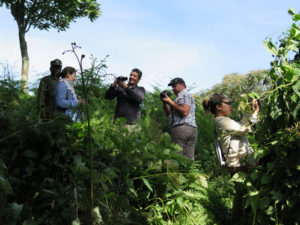 How are the gorilla groups allocated? Initially when gorilla trekking was just getting popular, gorilla groups in Uganda were allocated months in advance on a first come first serve basis. A traveler would read information about the different gorilla families and decide that they wanted a specific one. They would come to the park knowing exactly which group they would be tracking. Uganda realized that it wasn’t practical because some gorilla groups were more popular and visited than other. Gorilla families with no Silverback, no young ones received fewer visitors. Permits for the Rushegura group in Uganda sold like hot cake because of their proximity to the starting point while Mubare was generally avoided.
How are the gorilla groups allocated? Initially when gorilla trekking was just getting popular, gorilla groups in Uganda were allocated months in advance on a first come first serve basis. A traveler would read information about the different gorilla families and decide that they wanted a specific one. They would come to the park knowing exactly which group they would be tracking. Uganda realized that it wasn’t practical because some gorilla groups were more popular and visited than other. Gorilla families with no Silverback, no young ones received fewer visitors. Permits for the Rushegura group in Uganda sold like hot cake because of their proximity to the starting point while Mubare was generally avoided.
Uganda decided borrow a leaf from Rwanda and decided that gorilla groups would be allocated on the day of the trek and in the park. Gorilla permits would no longer have names of the gorilla groups but only sectors. It would then be the responsibility of the park officials to allocate the groups based on the following:
Level of fitness: Mountain gorillas live in forests and sometimes areas of high altitude. To get to some of the gorilla groups, one has to trek through difficult terrain consisting of thick vegetation, hills and valleys. To make matters worse, some gorilla groups live far away from the starting point. Gorilla groups are therefore allocated based on the overall fitness of the travelers. Travelers who are not very fit will be assigned nearby gorilla groups. The park officials do not have a fitness test and use looks to decide who should get the easier trek. It is therefore important to let the park officials know your fitness concerns if you want an easier trek. If you consider yourself fit and want a group that is more challenging, you need to let the officials know. If you are a senior or disabled, you can be provided with a Sedan chairs and a group of porters. You can read more about the Sedan chairs in our article about gorilla trekking for the disabled and elderly.
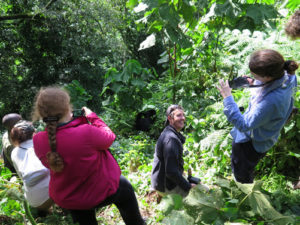 Age of Travelers: This is related to level of fitness. Age is one of the factors considered when allocating gorilla families to travelers. The park officials will try to estimate the age of travelers by appearance or using information on the passports. Age is not a good indicator of overall ability to complete a hike. It is possible for someone who is 60 years old to be fitter than a 23-year-old. If you are over 60 and feel that you are fit enough for a tougher hike, you should let the park officials know. The same goes for those who are young but are unfit. Younger traveler (below 19) are usually given easy or medium treks because they tend to be less focused and mentally prepared for the activity. They may have just come to give mum and dad company.
Age of Travelers: This is related to level of fitness. Age is one of the factors considered when allocating gorilla families to travelers. The park officials will try to estimate the age of travelers by appearance or using information on the passports. Age is not a good indicator of overall ability to complete a hike. It is possible for someone who is 60 years old to be fitter than a 23-year-old. If you are over 60 and feel that you are fit enough for a tougher hike, you should let the park officials know. The same goes for those who are young but are unfit. Younger traveler (below 19) are usually given easy or medium treks because they tend to be less focused and mentally prepared for the activity. They may have just come to give mum and dad company.
Gorilla permits and sector of the park: A gorilla permit is the document that allows one join a group to track a particular gorilla group. This document will be asked on the day of tracking. In Uganda, the gorilla permit you have will determine the gorilla group you are allocated. Gorilla permits in Uganda have the sector of the park indicated on them. If you acquire a permit for say Rushaga sector, then you can only be assigned a gorilla group in the Rushaga sector.
The preference of the traveler: The preference of the traveler is still taken into consideration when assigning gorilla families. It is important to let your tour company know that you are targeting a specific sector or have a gorilla group in mind. This will allow the tour company plan accordingly. Some tour companies are influential and can get you the group you are looking for. They can also get you the permits even when everyone is claiming they are over.
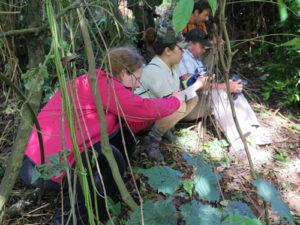 Season of the year: During the peak season, gorilla permits are very difficult to find. Getting your favorite gorilla group may be very difficult. You have to be very lucky to get your favorite family. However, during the low season, your chances of tracking your favorite groups is high. There are fewer tourists and park officials are more open to discussion.
Season of the year: During the peak season, gorilla permits are very difficult to find. Getting your favorite gorilla group may be very difficult. You have to be very lucky to get your favorite family. However, during the low season, your chances of tracking your favorite groups is high. There are fewer tourists and park officials are more open to discussion.
Number of times you have already tracked: If you have already tracked a particular family a day before – what we call double gorilla trekking, the park officials will have no choice but assign you the gorilla group of your choice. This factor is very important if you want to see or film a particular gorilla group. By tracking more than once, you have a very good chance of determining your next family because you would have created rapport with the ranger. If you gave some tip to the rangers on your first trek, your bargaining power becomes unbeatable.
Note: If you are tracking the gorillas in Bwindi and on your own, it is important to choose your accommodation facility at the sector you were allocated. Bwindi is a large forest and you don’t want to miss the activity simply because your hotel was too far away from the starting point. Book your trip in advance. This is to allow your tour operator to book the permits in time. It is also important to note that regardless of which gorilla group you end up being allocated, you will have a different experience. The chances of seeing the gorillas is very high indeed because an advance team of trackers are sent before sunrise to find the exact location of the primates.
How to cope with a difficult trek and gorilla group
What if I get a harder trek? If you end up with a more difficult trek for whatever reason, you can still enjoy the activity by getting mentally and physically prepared. Before arriving for the activity, walk for long distances near your home. If you live in a forested area or areas of high altitude, use them as practice ground. Ensure that you have come with all the important items mentioned in the gorilla trekking packing list. These include sturdy hiking boots to deal with the mud, hand gloves, long-sleeved shirts, a hat, sun glasses, a rain jacket, a sweater and insect repellents. You should also ensure that you move with a walking stick, enough drinking water and energy snacks to deal with dehydration and hunger. Don’t forget your camera, a binocular and toiletries. If you carry along the above items, you will complete the trek without much difficulty.
Moreover, Porters are available for hire at the starting point of the trek to help you with any heavy equipment at a small cost. You should hire a porter even if you believe you don’t need them. They will also help you with the difficult sections of the hike. Hiring a porter is one way of contributing to their economic well-being. In fact, some of them are students who are looking for some money to save before going back to school.

